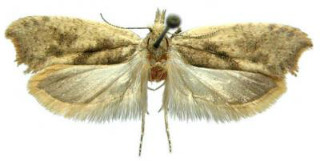Two new species of the genus Ypsolopha from the Russian Far East described in ZooKeys
Community and Forum → Blog → Two new species of the genus Ypsolopha from the Russian Far East described in ZooKeys
Lev Bely, 18.04.2013 23:22
ZooKeys 289 (2013) issue features the descriptions of two new moth species of the genus Ypsolopha from the Russian Far East. The authors of the study are Margarita Ponomarenko and Yuliya N. Zinchenko, Institute of Biology and Soil Science FEB RAS.
Moths of this genus are remarkable for their unusual resting pose with bottom upturned and antennae stretched forward. Larvae are as much worth attention: they weave web nests on buds, leaves and twigs to live and feed in, and their cocoons they form on a host plant are shaped like a cradle.
Ypsolophid moths are rather hard to catch. Common ways to collect adults by breeding larvae or attracting imagoes by light don't work quite well with Ypsolopha moths, since larvae of most species of this genus live secludedly on host plant and are hard to discover in nature. It's a big luck for entomologists to find them and a double luck when a moth appears to be new and yet undescribed species.
Russian scientists had the luck to spot and describe two new species of the genus Ypsolopha from the south regions of the Russian Far East. The details of the study are published in ZooKeys 289 (2013) : 25-39 (http://www.pensoft.net/journals/zookeys/issue/289/).
Due to that Ypsolophid moths are thermophilic, they prefer warmer parts of the south regions of the Russian Far East. Over the past 10 years the number of described species has increased more than twice and reached 30 including two new species. This is a fourth of all moths of the genus Ypsolopha known by now.
“Faunistic studies are not only a whim! Exploring species diversity is a task with ecological repercussions on a local, and global scales”, explains Dr. Ponomarenko, Institute of Biology and Soil Science, Far Eastern Branch of Russian Academy of Science. “Studying the species diversity in East Asia as a whole and in the Far East of Russia in particular is an important endeavour. Faunistic investigations are only the first step in a long row of scientific tasks towards forming a primary database for further theoretical reconstructions and conclusions for the benefit of biodiversity conservation and species preservation.”
EurekAlert!, http://www.eurekalert.org
Photo: the new species Ypsolopha straminella, Margarita Ponomarenko, http://www.eurekalert.org
All the rest posts on: Asia, science, new species, Russia, ecology
Comments
New comment
Note: you should have a Insecta.pro account to upload new topics and comments. Please, create an account or log in to add comments.
* Our website is multilingual. Some comments have been translated from other languages.
Random species of the website catalog
News
- 02.03.2025: Moscow Insect Fair: New section on the Insecta.pro Website
- 31.12.2024: If you need to upload a lot of photos to Insecta.pro website
- 10.12.2024: Новое поле в «Поиске энтомологов»
New photos (27.03.2025)
Fresh from the community
- 23:09, M. Niobius: Здравствуйте. Тульская область, окт...
- 12:52, L. Bolshakov: Петр, см. там подробности: https://...
- 12:32, P. Khramov: Лавр, источник скиньте, пожалуйста....
Popular insects
Recommended blog topics
- ICZN Election of Commissioners
- A. Gordon, O. Gorbunov, V. Murzin on Russian TV in 2004
- Meanwhile, in Kotelnich
- Butterfly farm to be built at Twiga Cement's mining sites in Tanzania




























